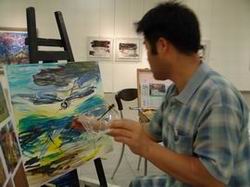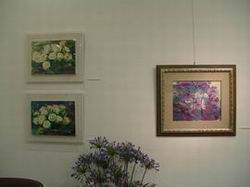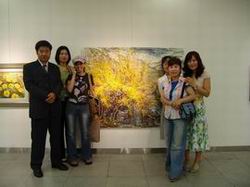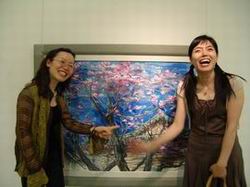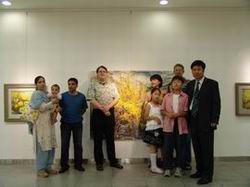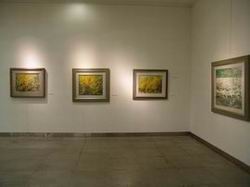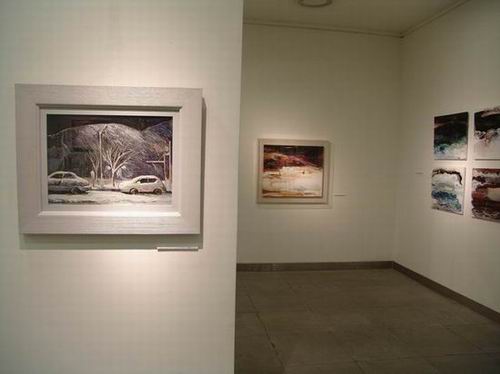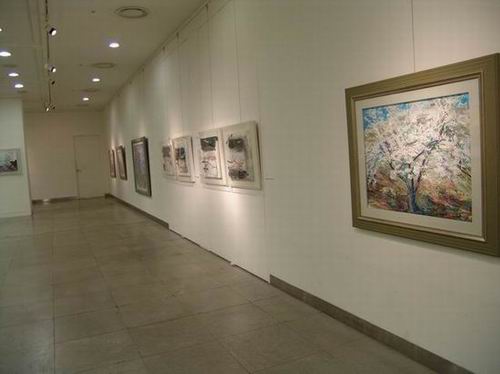"The Bow gallery" in Ulsan(Korea) - 보우갤러리(울산)
December 9~15, 2006

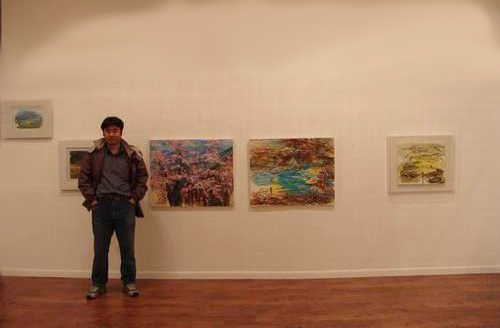
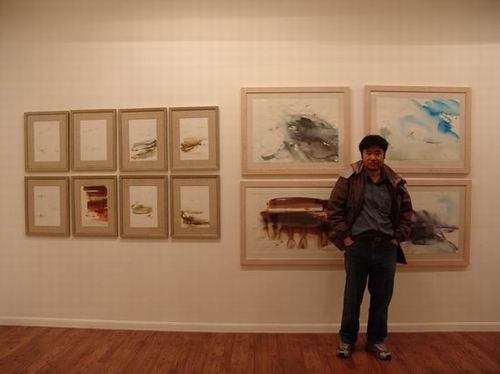
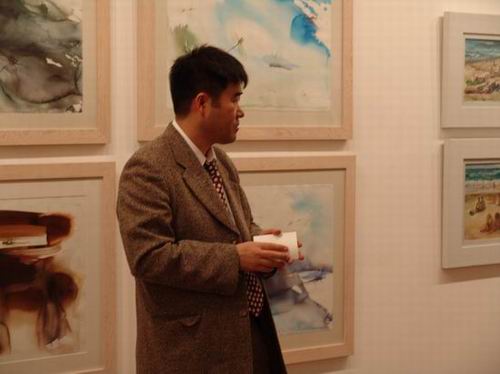
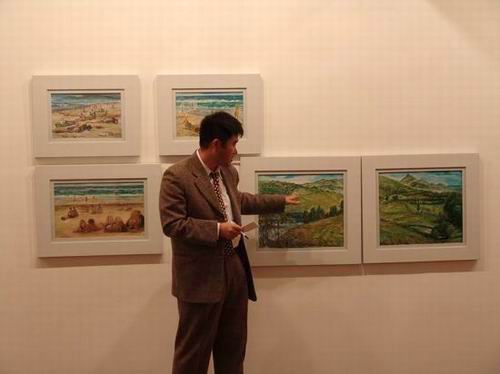
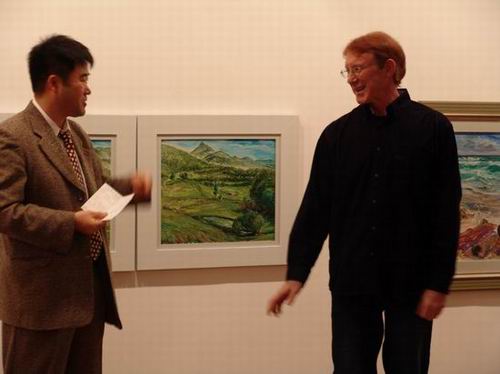
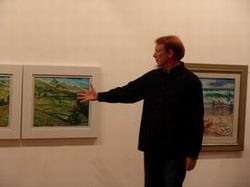
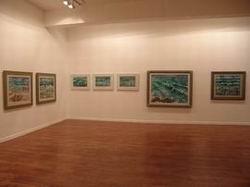
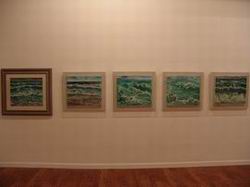

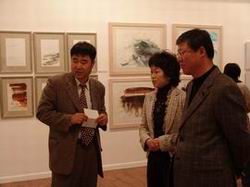
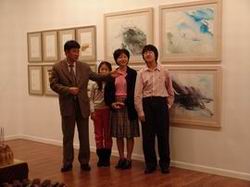
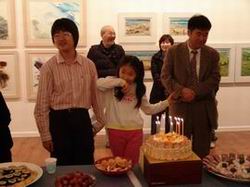
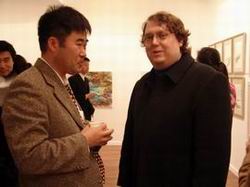
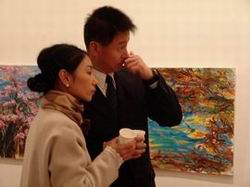
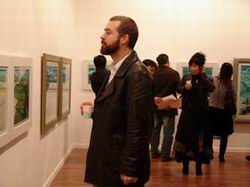
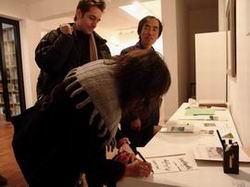
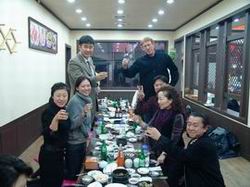
"The Hyundai gallery" in Ulsan(Korea) 현대아트갤러리(현대백화점,울산)
June 21~26, 2005
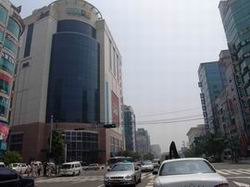

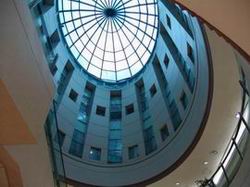
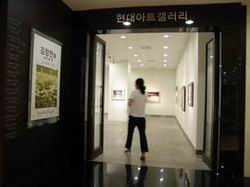
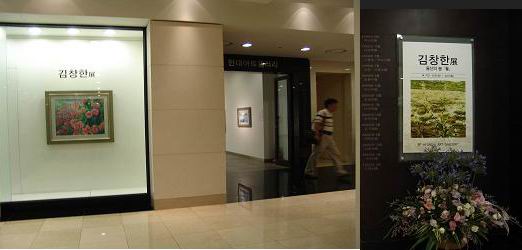
2, 금번에 전시할 작품은 100~10호 크기에 유채와 아크릴을 재료로 늦겨울의 잔상(殘像)을 시작으로 통도사(通度寺)의 홍매(紅梅), 울산의 벚꽃, 개나리, 진달래, 배꽃, 장미 등 약 30여점의 작품으로 꽃 잔치를 펼친다.
‘울산의 봄’展을 갖기로 생각한 것은 2년 전이다.
1991년 서울서 대학원을 졸업하면서 첫 대학 강의를 위해 내려온 부산에서 2년간의 생활을 접고, 잠시 울산에 들렀던 것이 벌써 13년째 된다.
3, 2005년 울산,
이곳은 내 삶의 터를 이루는 절실한 생업의 현장이다.
우리나라 최대 공업단지에서 24시간 환한 불을 밝히면서 끊임없이 돌고 있는 공단과, 빌딩 숲은 하루가 다르게 늘고 있다. 시민의 약70%가 타지에서 직장관계로 모여서 그런지 역동적이다. 또한 이곳은 우리 선사(先史)인의 장대한 문화적 보고(寶庫)인 반구대 암각화와 천전리 각석에서 볼 수 있는 것처럼 대자연의 풍요로움과 수준 높은 예술이 오랜 세월 함께해 왔다. 지금은 보기 힘들지만 고래는 울산을 특징짓는 또 다른 명물이다.
4, 내 그림의 주된 모티브는 자연이다. 작품의 대부분은 야외사생을 통해 이루어진다.
내가 잠자리와 사과 과수원을 소재로 그림 그린 것은 15년 쯤 된다. 들꽃도 가끔 그리긴 했지만 잠깐뿐이었다. 특히 봄꽃이 피는 시간은 너무나 짧기 때문에 항상 아쉬움을 느꼈다.
‘울산의 봄’展에서 담고자한 것은 자연의 미(美)만은 아니다.
내 마음속의 고향에 대한 그리움과 삶에 대한 이상향 담고자 했다.
나는 중학교 때부터 들과 산으로 그림 그리러 다니기 시작했다.
야외에서 그림 그리는 것은 나의 유일한 취미활동이며 휴식시간이고, 내 직업(미술교사/작가)을 더욱 빛낼 수 있는 연구 활동이기에 무엇보다 소중하다.
각종 도구를 겹겹이 챙기고서 작열(灼熱)하는 태양 아래서 하루 종일 몰두한다는 것이 결코 쉬운 일은 아니지만 어찌 그림 그리는 기쁨과 비교할 수 있을까.....
5, 매년 봄이 되면 이곳은 꽃들로 장관을 이룬다.
너무나 흔한 것들이지만 가만히 그들을 볼 땐 어린시절 뒷동산에서 뛰놀던 추억들이 떠올라 내 마음을 설레게 한다.
배고픈 어린시절 진달래꽃을 한껏 따먹으면서 짙푸른 분홍빛에 취해 해가 지는 것도 잊으면서 하루 종일 뒷동산에서 뛰놀던 그때가 그립다.
6, 울산은 배가 유명하다.
해마다 봄이 되면 이곳 웅촌과 청량면 일대는 순백의 배꽃이 흰눈처럼 소복이 천지를 뒤덮는다.
울산에서 10여년의 세월을 보낸 지금, 내가살고 있는 이곳은 수 천년 역사를 간직한 대자연의 장엄함과 오묘한 신비스러움을 매년 봄이 되면 진달래 개나리와 함께 찬란한 배꽃 잔치를 펼치면서 내 가슴속에 또 다른 마음의 고향으로 다가오고 있었다. 2005, 봄
On the fruition of my long-planned exhibition, Spring in Ulsan
Although summer has barely arrived, this has already been a very busy year for me. This showing, Spring in Ulsan, is my fourth solo exhibition in 2005.
The rest of the year will be busy as well. I have two more upcoming exhibitions scheduled, including one in Australia in August and another in Japan in October. These overseas exhibitions are of great significance, because they offer the opportunity to share my Korean perspective with art-lovers abroad. I must continue to work diligently to develop and express my artistic vision. I am reminded of 1985, when I entered the 1st Seoul International Marathon in 1985. After 37km, I was exhausted and unable to run any farther. Challenging myself to the limit has remained in my heart as a great and meaningful experience. Fortunately, I have more endurance as an artist than as an athlete. This time, I will run the full course.
In this exhibition, I will be showing 30 paintings in oils and acrylics. The main motif is floral, including the ume, cherry blossoms, forsythias, azaleas, pear blossoms and roses. Most of these were painted within the last two years around Ulsan and at Tongdo Buddhist Monastery. They represent a progression from dormancy in late winter to full-bloom in spring. Although this seasonal cycle is quite common, it always makes my heart leap with reminiscence of my childhood days on the hillside which used to be my playground. I long for the time when I was too much absorbed in play to think of the sunset, satisfying my hunger with azalea and being drunk with its dark pink color.
I have been planning Spring in Ulsan for two years. It has already been thirteen years since I moved to Ulsan from Busan, where I had spent two years as a university lecturer upon completing graduate school in Seoul in 1991. Since that time, I have witnessed the nation's largest industrial complex operating around the clock, and the developed area of the city has steadily grown. About 70% of the exploding population here is people coming from different parts of the country for jobs, and this diversity among the citizens helps to make Ulsan dynamic and interesting. Living in this great city for over a decade has made it the hometown of my heart.
Underlying the recent expansion and development, Ulsan and its outlying countryside have an age-old history of magnificent artwork, much of which is now considered ancient cultural treasure, including the petroglyphs of Bankudae, and the tessera of Cheonjeon-ri. It is fantastic to think now about the plentiful whales hunted by the people of this area so long ago. Another natural treasure of this area are the wonderful pears. There are pear blossoms as white as snow all around Woongchon and Cheongryang-myeon every spring. Blooming alongside azaleas and forsythias, the pear blossoms create a mystical atmosphere and convey the majesty of nature.
Since childhood, I have often gone out to sketch and paint on hillsides and in fields. Making art outdoors is not only my most fulfilling pastime, from which I derive great rest and rejuvenation, but also one of the research activities through which I can devote myself to my professions as artist and writer. It is never easy to make outdoor excursions with various supplies and equipment, and it can be laborious to be absorbed in painting under a scorching sun for many hours of the day, yet none of these hardships can compromise the joy of rendering natural glory into a piece of art.
Throughout my career, I have usually made nature the major subject of my paintings. Most of my works have involved outdoor sketching and painting. I have painted dragonflies and apple orchards for about fifteen years. During this period, wild flowers occasionally appeared in my paintings. Concerning the brief life of flowers in spring, I have always felt the desire to express some of the feelings that they inspire in me. What I want to incorporate into Spring in Ulsan is not only the beauty of nature, but also a nostalgic sense of a homeplace well-loved, as well as a longing and hunger for natural utopia or Shangri-la. Spring 2005, edited by Daniel
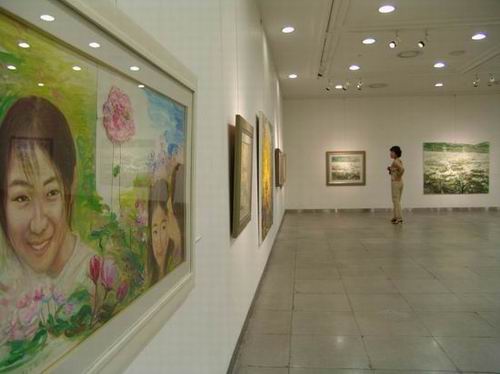
악마처럼 빛나는 눈빛 : 사과 꽃이 활짝 핀 과수원에서 천사처럼 웃고 있는 소녀는 바로 내 딸 은비다. 나는 오래전부터 사과 꽃을 그리고 싶었다. 하지만 기회를 만들기 어려웠다. 작년 봄, 사과 꽃을 그리기위해 경북 봉화에 있는 시골집 사과과수원까지는 멀어서 미처 가지 못하고 영천에서 잠시 내려 두 점을 그렸다. 그 때 찍었던 사진을 부분적으로 참고해서 본 작품을 그렸다. 그렇다. 사람이 꽃 보다 더 아름답다. 울산의 봄은 꽃보다 아름다운 은비의 미소와 함께 내 마음의 고향으로 다가왔다.
The devilish glint in her eyes… The little girl with the angelic smile is my daughter Eunbi, painted in orchards of apple trees in full blossom. I wanted to paint apple blossoms long ago, but couldn't find the time. Last spring, I painted two landscapes of the apple orchard at Youngcheon on the way to the country orchard at Bonghwa in Kyeongbuk. This was where I originally considered the optimal place to paint apple blossoms, but had given up on going because of the remoteness of the location. This painting was completed in part by reference to the photographs taken on the one day I managed to steal away there. To be sure, the human flower was far prettier than those on the trees.
고향의 봄 - 몇 년전 통도사(通度寺) 성보박물관(Tongdosa Museum)에서 국민적 애창곡(national folk song) '고향의 봄'의 가사를 쓴 이원수(Lee Wonsu) 선생에 관한 다양한 모습을 볼 수 있었다. 마치 30년 전 초등학생 시절로 돌아간 기분이었다. 그분의 고향이 내가 살고 있는 곳과 바로 인접한 양산인 것을 알았을 때 더욱 친근감이 들었다. 언제 들어도 가슴 뭉클한 ‘고향의 봄’은 울긋불긋 꽃동네에서 그분이 본 이상향과 함께 내 가슴에 녹아든다.
나의 살던 고향은 꽃 피는 산골 복숭아꽃 살구꽃 아기 진달래
울긋불긋 꽃 대궐 차린 동네 그 속에서 놀던 때가 그립습니다.
꽃 동네 새 동네 나의 옛 고향 파란 들 남쪽에서 바람이 불면
냇가의 수양버들 춤추는 동네 그 속에서 살던 때가 그립습니다.
That hometown feeling
A couple of years ago, I found out about Lee, Weon-Su, a songwriter who wrote the famous song 'Spring in my Hometown' at the Seongbo Museum in Tongdo Buddhist Monastery. Listening to his lovely lyrics, I felt transported to my childhood thirty years ago. When I learned that his hometown was Yangsan, very close to where I grew up, I felt his message even more deeply. I cannot hear the 'Spring in my Hometown' without feeling a great swell of emotion. The Shangri-la that he evokes from the universal picturesque hometown is well-imprinted in my heart.
Spring in My Hometown
My hometown was a remote mountain village where flowers bloomed
With peach blossoms, apricot blossoms, azaleas
My hometown was a flowery palace
I miss my childhood in my hometown
Village of flowers and birds was my old hometown
When wind blows from the south of the green field
Weeping willows dance
I miss my youth in my hometown

